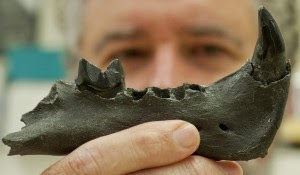
A 5-million-year-old saber-toothed cat, the world’s oldest grape and a bizarre hermit crab were among more than 100 new species discovered by University of Florida scientists last year.
Driven in part by the urgency to document new species as natural habitats and fossil sites decline due to human influences, researchers from the Florida Museum of Natural History, located on the UF campus, described 16 new genera and 103 new species of plants and animals in 2013, with some research divisions anticipating higher numbers for 2014.
An online search shows the only other major research institution reporting similar information is the California Academy of the Sciences, which described 91 new species in 2013 and has averaged 115 per year since 2009.
“Traditionally this isn’t a number many research institutions have tracked,” said Florida Museum Director Douglas Jones. “But the extra emphasis on biodiversity due to degradation of natural habitats and accelerating extinction rate of plants and animals worldwide has placed a higher emphasis on researchers documenting and describing new species before they disappear.”
UF researchers discovered species from more than 25 countries on four continents, including 35 fossil crustaceans, 24 Lepidoptera, 17 plants (11 fossils), eight mollusks, two fossil mammals and one fossil bird, among others. Thirty-one additional species were identified in the museum’s collections by visiting researchers.
Don Davis, curator of Lepidoptera at the Smithsonian Institution’s National Museum of Natural History, said the Florida Museum has actively pursued the goals of all natural history museums, including discovering new organisms to better understand the current distributions and history of all life.
“The scientists there are providing not only new knowledge for a broad range of organisms, but also an excellent, well-documented specimen database for all future researchers in natural history,” Davis said.
Scientists often happen upon new species while working in museum collections or exploring in the field, but recent museum biodiversity projects and collaborations have focused on discovering as many new species as possible.
Museum scientists utilized advanced taxonomic methods during recent biodiversity survey projects, including DNA bar coding, a process that uses a genetic marker to identify if an organism belongs to a particular species. Some of the new species discovered during these surveys prove rare discoveries still occur.
For example, during an international effort to document all animals and plants living on and in the waters surrounding the island of Moorea in French Polynesia, Florida Museum invertebrate zoology curator Gustav Paulay dredged from the deep sea a new hermit crab that exemplifies a rarely documented process in which hermit crabs move out of their shells and harden their bodies to resemble true crabs. Patagurus rex has a broad, armored body with pointy spines and long legs connected to large claws — making it one of the most distinctive hermit crabs discovered in decades, Paulay said.
“There is this idea that we can grab a field guide and work out there as scientists,” Paulay said. “But for large chunks of the world, those resources don’t exist and the science that would support those resources is just not there.”
This is especially true for museum scientists studying some of Earth’s smallest species in remote jungles of the Congo and isolated areas of Hawaii.
Florida Museum assistant curator of Lepidoptera Akito Kawahara said new species of insects sometimes lead to powerful discoveries that affect other fields, including agriculture and medicine.
“Future research will include the investigation of a potential new species of moth in Hawaii that appears to delay plant aging by altering the process of plant senescence (aging) in leaves,” he said. “This moth could have potential for improving agriculture and extending the shelf life of some foods.”
Last year, many scientists looked for new species from the past. Museum scientists described 56 new species of fossil plants and animals. Among these, the world’s oldest-known grape species, Indovitis chitaleyae, discovered in 2005 and described in 2013, pushed the record of the Vitaceae (grape) family into the Late Cretaceous, about 66 million years ago.
Florida Museum vertebrate paleontology collections manager Richard Hulbert described the 5-million-year-old fossils of Rhizosmilidon, a carnivorous saber-toothed cat from the same lineage as the famous Smilodon fatalis from the La Brea Tar Pits of Los Angeles.
“Today’s species represent only about 1 percent of life that ever existed,” said Bruce MacFadden, Florida Museum curator of vertebrate paleontology. “It is important to understand the other 99 percent of biodiversity that once inhabited the planet, because knowledge of the kinds of plants and animals that lived here in the past provide us with a framework for understanding today’s ecosystems.”
Note : The above story is based on materials provided by University of Florida.










